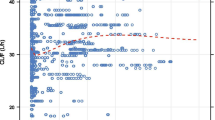Abstract
Objective: The clinical outcome of patients after organ transplantation is correlated with cyclosporin A (CyA) exposure. It is generally accepted that the area under the concentration–time curve (AUC) provides a reliable means for drug exposure. However, in routine therapeutic drug monitoring (TDM) of CyA, trough levels are mostly used. Currently, a number of different new concepts of CyA-TDM, including approaches such as single, double or triple time-point and abbreviated AUC determinations, have been introduced. The purpose of this study was to compare the predictive value of the different strategies of TDM.
Methods: Calculations were based on 40 individual concentration–time profiles after oral administration of CyA to patients who had been included into an ongoing prospective clinical trial. Non-compartmental analysis was used to calculate the AUC0–12h. Multiple linear regression was performed to describe the relationship between the different sets of blood concentrations and the respective AUC0–12h as well as to evaluate their predictive value regarding AUC. Predictive performance was assessed by prediction bias and prediction precision, which were estimated as the mean prediction error and root mean squared error, respectively.
Results: When comparing the various combinations of time points, it was found that one-point approaches showed the strongest differences with regard to the predictive value; the associated r2 values differed from 0.203 to 0.792. The two and three time-point approaches showed lower differences – r2 0.802–0.972. The four-point and five-point approaches (r2 0.942–0.982) were the strongest predictors for CyA AUC0–12h. Relative bias ranged from −27.7% to 63.8% and changed significantly when multiple-point predictors were used. In those cases, the predictive performance improved. Considering the predictive performance as well as the smallest bias and highest prediction precision, C3, C1 + C3, C1 + C3 + C6 and C1 + C2 + C3 + C6 were the best predictors.
Conclusion: The results of this study indicate that in kidney transplant patients a clinically sufficient precise estimation of the CyA AUC is possible using two or three concentration–time points.
Similar content being viewed by others
Author information
Authors and Affiliations
Additional information
Received: 18 November 1999 / Accepted in revised form: 10 February 2000
Rights and permissions
About this article
Cite this article
Wacke, R., Rohde, B., Engel, G. et al. Comparison of several approaches of therapeutic drug monitoring of cyclosporin A based on individual pharmacokinetics. E J Clin Pharmacol 56, 43–48 (2000). https://doi.org/10.1007/s002280050718
Issue Date:
DOI: https://doi.org/10.1007/s002280050718




